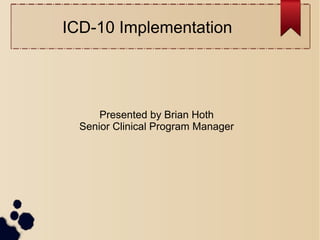Icd 10 implementation information and plan
•Download as PPT, PDF•
0 likes•330 views
The document outlines the ICD-10 implementation process which includes 4 phases: 1) Developing an implementation plan and assessing impacts, 2) Preparing for implementation through training, testing, and system changes, 3) Preparing for the go-live date through final testing and training, and 4) Following up after go-live to monitor outcomes, provide additional training, and resolve issues. The Federal Government has mandated compliance to the new ICD-10 codes by October 1, 2014, representing a significant improvement over ICD-9 but requiring a well-managed implementation across healthcare organizations.
Report
Share
Report
Share

Recommended
Recommended
More Related Content
Similar to Icd 10 implementation information and plan
Similar to Icd 10 implementation information and plan (20)
Q1 Medical Devices Regulation - practical consequences for manufacturers

Q1 Medical Devices Regulation - practical consequences for manufacturers
Presentaion: Updates to Good Manufacturing Practices

Presentaion: Updates to Good Manufacturing Practices
Project Management and Development Economics Project (Slides)

Project Management and Development Economics Project (Slides)
Evaluation of Information Systems in Health Care Must be in APA .docx

Evaluation of Information Systems in Health Care Must be in APA .docx
IFC+Guidelines+for+Coaching+on+Food+Safety_ENG.pdf

IFC+Guidelines+for+Coaching+on+Food+Safety_ENG.pdf
Icd 10 implementation information and plan
- 1. ICD-10 Implementation Presented by Brian Hoth Senior Clinical Program Manager
- 2. ICD-10 Introduction ● The Federal Government has mandated compliance to the new ICD-10- CM/PCS codes on 10/01/2014 for all Healthcare entities. ● ICD-10-CM/PCS represents a significant improvement over ICD-9-CM for the following reasons: – To overcome many limitations and allow for flexibility in adding new codes. – Incorporate greater specificity and clinical detail resulting in major improvements in the quality and usefulness of coded data. – Updated terminology and classification of diseases to be consistent with current clinical practice. – Improved structure and capacity for capturing technological advances. – More flexible and able to accommodate revisions necessitated by medical advances.
- 3. ICD-10-CM/PCS Uses ● ICD-10-CM will be used in all healthcare settings, both inpatient and outpatient, and by all types of providers for the reporting of diagnoses. ● ICD-10-PCS will be used for procedure coding, and will only be used for the reporting of hospital inpatient services. ● CPT® and HCPCS Level II codes will continue to be used for the reporting of physician and other professional services as well as procedures performed in the outpatient setting (e.g., hospital observation services, clinic settings, physician office setting, home health, etc.)
- 4. ICD-10 Implementation Scope The scope and complexity of the implementation are monumental and should not be underestimated. A smooth, successful transition will require a very well-planned and well- managed implementation. Proper planning and preparation throughout the timeline of the project are critical for a healthcare organization to ensure a successful move towards full compliance by the October 1st, 2014 deadline.
- 5. Implementation Phases ● Phase 1: Implementation plan development and impact assessments ● Phase 2: Implementation preparation ● Phase 3: "Go-live" preparation ● Phase 4: Post-implementation follow-up
- 6. PHASE 1: IMPLEMENTATION PLAN DEVELOPMENT AND IMPACT ASSESSMENT ● Create an interdisciplinary steering committee, this committee should represent all key stakeholders throughout your organization. A Project Manager will lead this committee ● Establish a plan of communication ● Impact Assessment and Initiate Resolutions ● Develop ICD‐10 implementation budget ● Assess training needs
- 7. PHASE 2: IMPLEMENTATION PREPARATION ● Vendor/Payer Contractual Issues ● Start training needed for personnel involved in data conversion ● Start training to individuals other than coding staff ● Documentation Improvement ● Evaluate Reimbursement/Productivity/Accuracy Issues ● Begin General Equivalence Mappings (GEMs) and Reimbursement Mappings ● Implement changes (either dual coding or in test environment) ● Develop strategies to minimize transition problems and maximize opportunities for successful transition
- 8. PHASE 3 : “GO LIVE” PREPARATION ● Confirm with systems vendor(s) that changes/upgrades and all other changes are complete ● Complete all remaining tests and any modifications due to tests ● Provide final round of training to all coders, end users and physicians ● Continue to assess quality of coding outcomes and make final modifications as necessary ● Rollout communication for go live ● Go live on October 1st, 2014
- 9. PHASE 4: POST‐IMPLEMENTATION FOLLOW‐UP ● Monitor impact on coding outcomes and make adjustments as needed ● Continue to meet as needed to provide issue resolution ● Train and re-train as needed to reduce user-based coding errors ● Resolve post‐implementation problems quickly such as claims denials/rejections or coding backlogs
- 10. PHASE 4: POST‐IMPLEMENTATION FOLLOW‐UP ● Monitor impact on coding outcomes and make adjustments as needed ● Continue to meet as needed to provide issue resolution ● Train and re-train as needed to reduce user-based coding errors ● Resolve post‐implementation problems quickly such as claims denials/rejections or coding backlogs